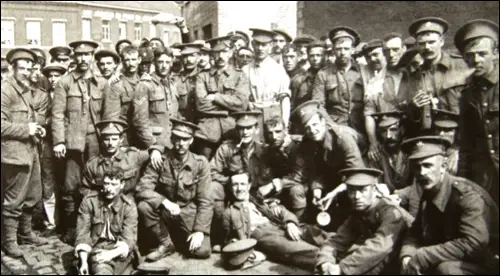British Expeditionary Army
After the Boer War, the British war minister, Richard Haldane, created the British Expeditionary Army (BEF), in case it was necessary to take part in a foreign war. By August 1914, there were about 120,000 soldiers in the BEF.
On the outbreak of the First World War, it was decided to send Sir John French and four infantry division to Belgium. By October 1914 the BEF had seven infantry and three cavalry divisions in France and Belgium.

In December the British Expeditionary Army was divided into the First and Second Army. A Third Army was created in July 1915 and a Fourth Army in March 1916.
Sir John French remained in charge of the until December 1915, when he was replaced by Sir Douglas Haig.
Primary Sources
(1) In the first few weeks of the First World War the journalist Philip Gibbs accompanied the British Expeditionary Force to the Western Front.
Along the roads of France and in the port of Boulogne, the B.E.F. was greeted with ecstasy by the French civilians who went mad at the sight of them. In every village girls threw flowers at them, ran alongside with gifts of frit, and flung kisses at them in wayside stations when they leaned out of the railway trucks. they had come to help save France. Nothing in those first weeks was too good for them.
(2) Manchester Guardian (18th August, 1914)
The official announcement of the completion of the landing of the Expeditionary Force in France makes it possible to publish in this country accounts of the despatch of the troops and their hearty welcome in France. These were appearing in the Paris papers nine or ten days ago.
Over the sides of a big transport towed and steered into Boulogne habour by four tugs this afternoon appeared the high mast and wireless aerial of a British warship. Along the piers which flank the waterway there were ringing French cheers for the soldiers crowding the transport's sides and rigging, but the crowds dispersed before the ship of war steamed into port.
The warship, which had made what was probably a record passage from Dover, carried Field Marshal Sir John French and the Headquarters Staff of the British Expeditionary Force. The swift and by all accounts smooth and efficient despatch of the Expeditionary Force overseas is a remarkable military achievement.
The army mobilisation proclamation was signed on the same day as the declaration of war against Germany - Tuesday, August 4. In less than a fortnight the landing of a fully equipped army on the Continent has been completed. And this has been done under the protection of the navy, with a powerful hostile fleet only 300 miles away.
Before war was declared, the Regular Amy at home was organised in one cavalry division, six divisions, and army and line of communication troops, with a total strength of about 165,000 men. This was to be the Expeditionary Force. What part of it has now been sent abroad the official statement does not say.


